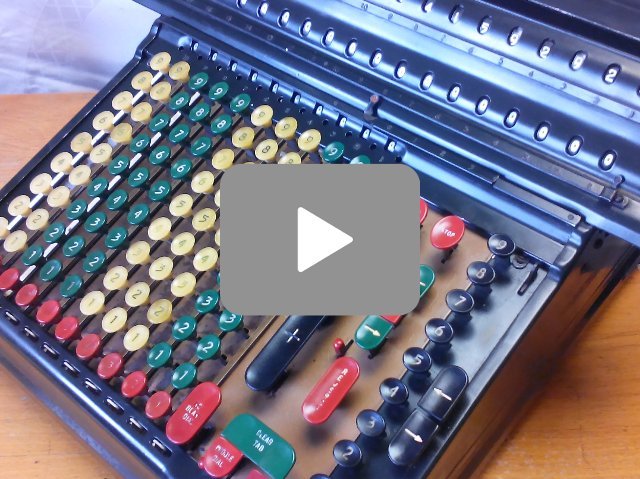Marchant Silent Speed ACT 10M
This video shows the mechanical calculator Marchant Silent Speed ACT 10M. An amazing calculator with silent and fast movement of dials. In the video you will enjoy
- division
- multiplication
- extraction of cube root
- work with tabulators
Marchant became a superstar on the field of mechanical calculators after introducing the "Silent Speed" calculators. You may read interesting stories about the Marchant calculators and the firm in the links at the end of this article. In my article I will focus the attention to the features which make the machine from the video, model ACT 10M, different from the model D, introduced in another video.
The main inovation in ACT is the speed. Marchant ACT works at 1200 operations per minute which is a double speed comparing to previous Silent Speed model and more than triple comparing to the other competitors. Marchant was the fastest calculator for a more than 30 year period (from 40's to 70's).
Multiplication
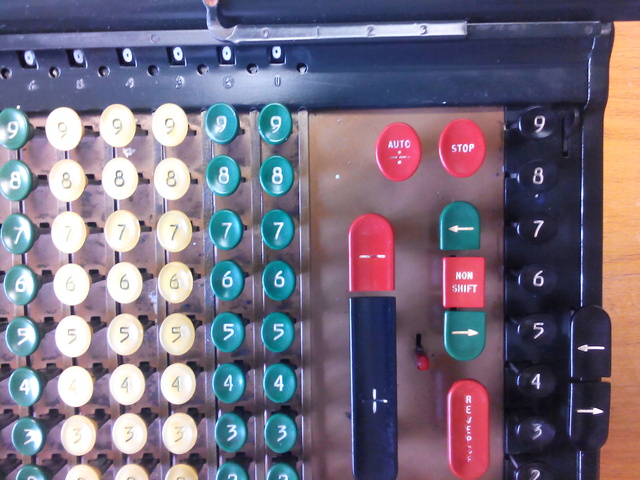
The calculator introduced a special multiplier - column of black numbers on the right. You just touch the key and the number from the keyboard is repeatedly added to the accumulator (middle register). After this step, the main register may shift to the left or to the right. This behavior depends on the state of the green arrows on the left from multiplier.
The task is cached during the computation. The keyboard and the multiplier are free while Marchant mutiplies. Therefore you need not to wait for the end of the operation. This is a big contrast to the other machines of other manufacturers. You can just press the next number in the multiplier. Consequently, the multiplication is performed on the fly as the user types the number on multiplier.
The button REVERSE switches addition to subtraction.
If you want to multiply a number by another number with three digits. you have to shift the accumulator to the third position from the right and start the multiplication. To do this easily, you can just touch the tabulator - the red key in bottom of the numerical keyboard.
Division
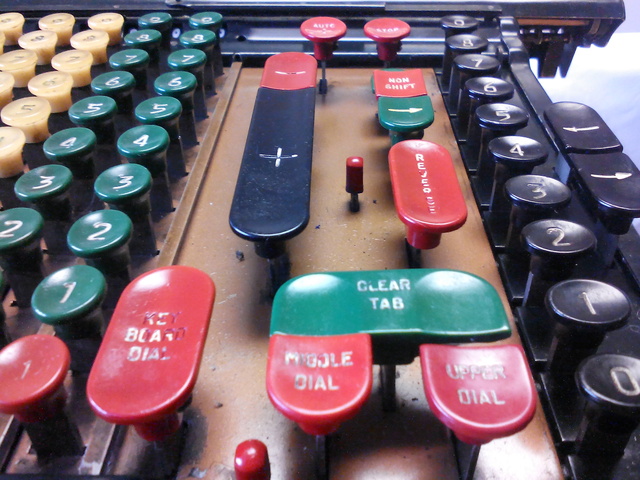
Division is similar like for the first Silent Speed models, just the speed is higher. Tabulators allow to shift to the initial position by pressing just one button. No need to keep the finger on the arrow key and wait till the carriage reaches the desired position.
A special lever on the right from the plus key ensures that the middle register is cleared after a division and the carriage is returned to the tabulator. This feature is recorded in the video, with exception of the first division, 355:113. As you can see from the video, the middle register contains the dividend when the division is initiated and the remainder when the division finishes. In most cases, the tabulator corresponding to the rightmost position is used. Thus the lever on (switched to the operator) forces the calculator to prepare for the next division automatically.
The cube root
The special method used to extract the cube root of any number is described in the document which can be found on the web of The National Museum of American History. From a mathematical point of view, the method is based on a linear approximation of the function using the derivative. In the case of the cube root function the linear approximation gives the formula $$\sqrt[3] x\approx \sqrt[3]{x_0}+\frac 23 \, \frac1{\sqrt[3]{x_0^2}} (x-x_0)=\frac{x+2x_0}{\sqrt[3]{x_0^2}}.$$ To find a cube root of $x$ we have to know a close number $x_0$ and the value of $\sqrt[3]{x_0^2}$. These numbers can be found in the special table linked above. This converts extraction of cube root into two additions and one division. The cube root of 777 is evaluated in the video accompanying this article at the time 1:20.
The table gives the cube root with five digits correct. More accurate result can be obtain by using the Newton-Raphson method. This method gives for the function $y=x^3-a$ and the cube root of $a$ the iteration formula $$x_{n+1}=x_n-\frac{f(x_n)}{f'(x_n)}=x_n-\frac{x_n^3-a}{3x_n^2}=\frac{\frac a{x_n^2}+2x_n}{3}.$$ Thus if $x_n$ is five digit cube root of $a$, we divide the number $a$ by the square of $x_n$, add a double of $x_n$ and divide the total sum by $3$, which gives the cube root with ten digits correct (Newton-Raphson method has a quadratic convergence).
The STOP button
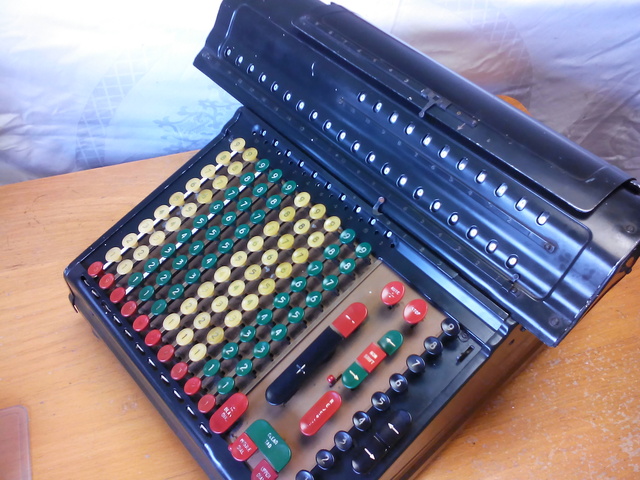
The button STOP is next to the button for automatical division. This button has several different functions.
The STOP button can be used to release pressed REVERSE button. It can be used also to release a button which has been pressed during power off.
The STOP button stops the division at any time. The calculator finishes the calculation of the current digit of the quotient and then stops. If the user pushes the STOP button for the second time, the division stops immediately.
The STOP button modifies the behavior of the division button. By default, the calculator clears the upper register with quotient when the division starts. The clearing of the upper register can be blocked by pressing the STOP before pressing division button and releasing it before releasing the division button. Usually the user initiates this feature by a two finger rolling motion.
The machine from the video
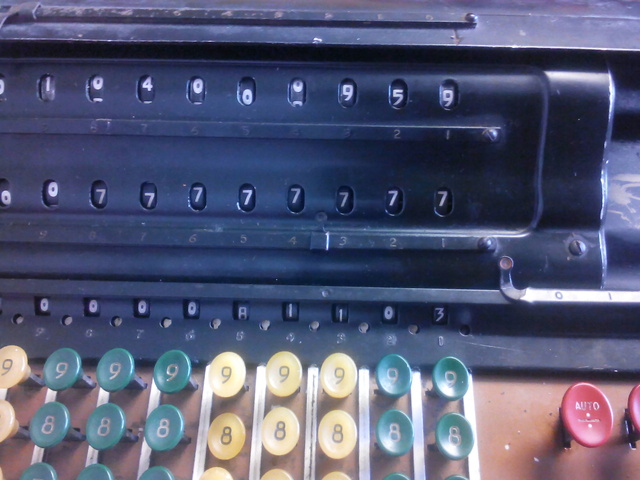
The calculator arrived in a box filled by papers from a paper shredder. Good idea to protect from mechanical damage, but the small papers were everywhere inside the machine. It was necessary to revise electricity, buy converter from 220V to 110V, replace broken capacitor, clean and unblock the blocked machine, adjust keyboard and multiplicator columns and do many other usual operations. However, the carriage was still not working properly and it was necessary to remove the wheels from the carriage, clean and assemble again. It is worth to say that this process was very difficult. There was no repair instruction manual available on the net. Some hints are written in the patent application which describes the mechanism. The paper Schwabe, Danny: Meine Erfahrungen mit Marchant. describes how another user succeeded to follow this method to rebuild the machine. This method requires total disassembling of the fish-bone-like skeleton. The famous collector John Wolff describes on his webpage another method. After many unsuccessful attempts I succeeded to find out how to insert the wheels to the register properly and the problems with the carriage have been fixed.
Literature:
- Marchant History by Ernest E. Jorgenson
- Detailed description of Marchant calculator by John Wolff
- Photos of Marchant ADX by Wim Hasselo
- Video with working Marchant 10AFE and detailed photos by Tiny Henst
- My Years with Marchant by Ernie Jorgenson
- Marchants: Some Preliminary Remarks by Nicholas Bodley
- Danny Schwabe: Meine Erfahrungen mit Marchant
Robert Mařík, November 2016
